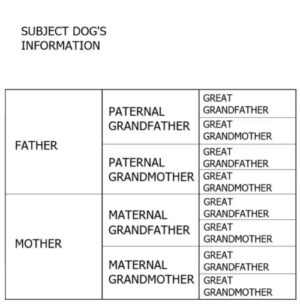
What are dog pedigrees?
Dog pedigrees are essentially family trees. They start with one dog, then his parents, then grandparents, and then great grandparents. It can continue further, but let's start with just three generations of ancestors.
In other words, it shows the relationship between a dog of one generation and his ancestors.
Here is a simple example of Peter of Faskally's pedigree. His name is on the left. The two slightly indented names are his parents - Waterdale Gamester and Birkhill Juliet. Indented further are his four grandparents - Spratt, Twinkle, Nith, and Susan. His eight great grandparents are indented even further.

For each pair, the male is on top, the female below. So Waterdale Gamester is Peter's father and Birkhill Juliet is Peter's mother.
In the next generation, Sprat is Gamester's father and Twinkle is Gamester's mother. Nith is Juliet's father and Susan is Juliet's mother.
Sometimes the main dog's name - in this case, Peter - will be at the top of the pedigree instead of on the left. Often there will also be information about him such as date of birth, color, breeder, and owner.
Most pedigrees only include direct ancestors and not siblings, as it shows in Peter's pedigree.
Sometimes pedigrees show more generations, but each generation back doubles the number of dogs in the previous generation. It doesn't take long to become unwieldy.
How to read a pedigree chart
A pedigree chart is another type of pedigree this time based on a grid. The top portion is used for the dog's information and possibly a small image.

The first column has 2 rows for the parents. The father is always in the top row and the mother in the bottom row. The second column is for the grandparents with the first two rows for the father's parents and the last two rows for the mother's parents.
The third column is for the great grandparents and is divided into eight rows. The first two rows are for the paternal grandfather's parents. The next two rows are for the paternal grandmother's parents. The final four rows are like above, but are for the mother's grand parents.
If you have a copy of Microsoft Excel or another spreadsheet program, it's easy to set up the rows and columns. Then it's just a matter of filling in the generations. Just refer back to your source documentation to make sure everything is correct
More information in dog pedigrees
Most pedigrees include additional information about the dogs listed. Usually they show each dog's color and date of birth. Often they show the registration number and titles of each dog. Sometimes they show even more information such as the breeder's name and sometimes their address.
Some pedigrees will show most dogs' names in black type and titled dogs in red. AKC abbreviations you might see include:
CH = Show Champion
GCH = Show Grand Champion
FC = Field Champion
MACH = Master Agility Champion
OTCH = Obedience Trial Champion
CDX = Companion Dog Excellent
JH = Junior Hunter
NAJ = Novice Agility Jumper
RE = Rally Excellent
TKN = Novice Trick Dog
Other clubs and organizations, such as the United Kennel Club, Hunting Retriever Club, and Super Retriever Series offer their own titles.
Another pedigree variation
A pedigree analysis chart is another type of pedigree. It's usually used to study heredity traits and disorders. However it can be used to show descendants of a dog or dogs.

This chart starts with a father and mother and shows their offspring linked downward. Symbols are used including squares for males and circles for females with a line linking a breeding pair.
A horizontal line links the offspring together with a link from the parents joining the horizontal line.
These charts often follow only one line of descent. For example, it will have a breeding pair with their offspring below. The next generation will usually only show the offspring of one son or daughter.
This type of chart is used to track inherited traits. For example, it might track coat color with a black father shown by a black square and a yellow mother shown by a yellow circle. If the father has a hidden yellow gene we'd add a yellow dot in his black square.
Their puppies would be shown linked below the parents. Each would be colored either yellow or black with a yellow dot.
Why add a yellow dot? All the puppies got a yellow gene from the mother. While the puppies got a black gene or a yellow gene from the father. The puppies that got the black gene will be black, but also carry a hidden yellow gene from the mother. Thus the dot.
Let's take a look at a few more examples
The first example is a page from a pedigree book. It shows five generations with some of the best bloodlines. The dog was bred by Sandylands, a very influential English kennel. He finished his show championship and was a popular stud dog. Several of my dogs descend from him!

Pitch was another influential dog. She had a dual champion granddaughter and at least two show champion kids. She's also line-bred on some very influential dogs. See if you can find the brothers in her pedigree. And, yes, she's in the pedigrees of several of my Labs.

Now that you know how to read a pedigree, you can create a pedigree for your dog. Or you can buy one at AKC if your dog is a registered purebred.
Another option is listing your Labrador on Hunting Lab Pedigree. You'll need to create a free account before you can add your dog.
If you'd like to include your dog's pedigree on your website, check out this article about creating a 3-generation pedigree for your website. It's free, and it's not branded by the author.


